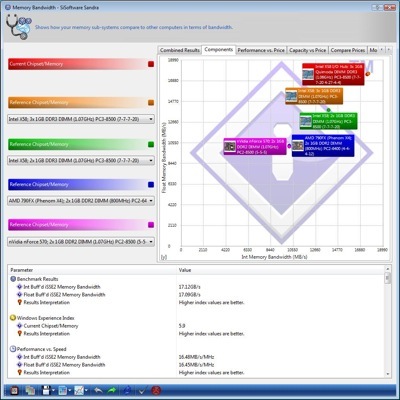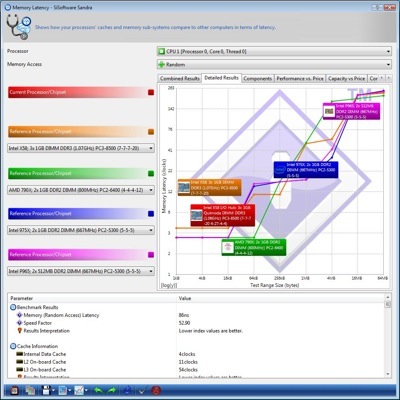Original URL: https://www.theregister.com/2009/07/01/review_memory_for_intel_core_i7_cpu/
The best memory config for a Core i7 CPU
All the options tested
Posted in Personal Tech, 1st July 2009 12:02 GMT
When Intel launched Core i7, the integration of the memory controller in the CPU core marked a major change from the Core 2 architecture. Intel was relatively slow off the mark in this regard: AMD moved the memory controller from the chipset to the CPU die in 2003 when it launched the Opteron.
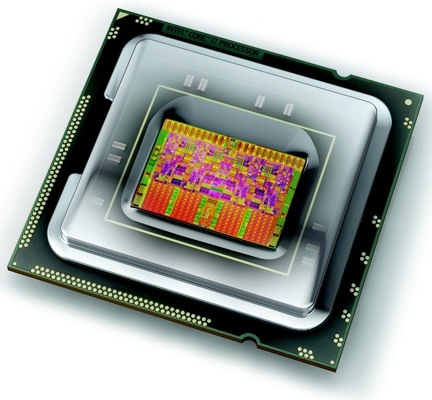
Intel's Core i7: the first Core with an on-board memory controller
Since then we've seen a dual-channel 1066MHz DDR 2 memory controller in AMD’s Opteron, Athlon 64 and Phenom processors, and this has been updated in the latest models of Phenom II and Opteron with the addition of a dual-channel 1333MHz DDR 3 controller.
Intel took a different approach with Core i7 and used a triple-channel DDR 3 controller to increase the memory bandwidth without requiring high memory clock speeds.
The chip giant stipulated a surprisingly low default memory voltage of 1.5V. Although the Jedec standard for DDR 3 includes an operating voltage of 1.5V, it's common to find that a higher voltage of 1.7V or 1.8V is necessary for the sort of clock speeds that we're used to seeing with Core 2 and Phenom II.
Motherboard manufacturers felt it was necessary to warn customers that raising the memory voltage above 1.65V could damage a Core i7 processor, although we see that they continue to offer overclocking options that would take the memory way beyond 2.4V.

It took a few months for low-voltage Core i7 DDR 3 memory to start rolling in from the manufacturers and naturally those kits contain three modules of memory rather than the traditional pack of two.
Memory Control: AMD vs Intel
Bandwidth
Latency
Prices of low-voltage DDR 3 memory have dropped substantially as a result, and you can buy 3x1GB kits of 1066GHz DDR 3 for less than £30, while 3x2GB kits start at about £60. This is a significant dividing line as a 32-bit operating system can ‘only’ support 4GB of Ram, and you have to deduct the graphics memory from that amount. The result is that most PCs can support 2.5-3.5GB of memory with the result that most Core 2 and Phenom PCs typically have 2GB of Ram installed.
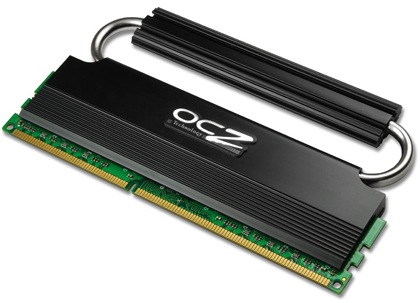
A Core i7 system running 32-bit software can have 3GB of Ram installed, which sounds as though it should be a step forward from 2GB.
On the other hand, if you step up to 64-bit Vista - or Windows 7 or Linux - you can install 6GB of Ram for £60. Most Core i7 motherboards have six memory slots - the exceptions that leap to mind are the Intel DX58SO with four slots and the latest Foxconn three-slot models - so you can install 12GB of DDR 3 in six modules for £120.
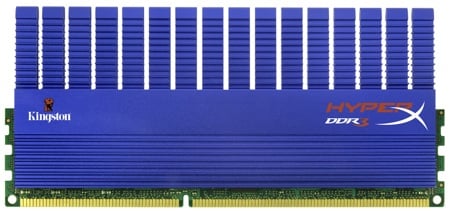
Faster DDR 3 is only slightly more expensive, with 3x2GB of 1600MHz DDR 3 available at a price of £80, while 2000MHz DDR 3 will take the cost past £100 for a 3x2GB kit. On the other hand, you can push the boat out and spend more than £250 for 3x2GB 2000MHz DDR 3, depending on the make and model that you choose.
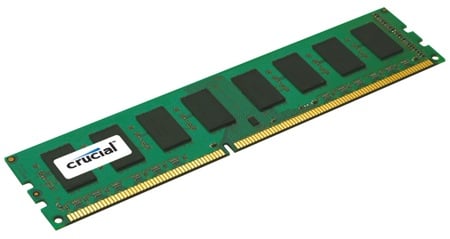
We decided to take a closer look at how the memory that you choose affects the performance of a Core i7 PC and have tackled four main questions:
- What is the effect of the triple channel memory controller?
- How does memory speed affect Core i7 overclocking?
- What speed memory should you use to get the best from Core i7?
- What quantity of memory should you install in your Core i7 system?
How good is triple-channel memory?
We started by setting up a test system with an Intel DX58SO motherboard along with a Core i7 920 processor, 3x1GB of Qimonda 1066MHz DDR 3 Ram and an Intel X25-M SSD running 32-bit Windows Vista Ultimate. The nature of the Intel motherboard with its four memory slots meant that we could install 3GB of memory in triple-channel mode, 2GB or 3GB in dual-channel, and 2GB in single-channel mode.
SiSoft Sandra Results
Bandwidth
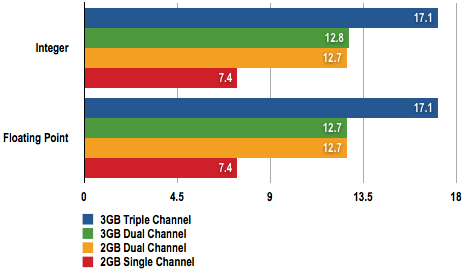
Memory Bandwidth in Gigabytes per Second (GB/s)
Longer bars are better
Latency
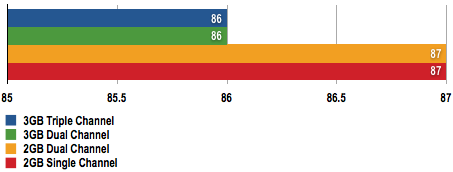
Memory Latency in Nanoseconds (ns)
Shorter bars are better
SiSoft Sandra shows that the memory bandwidth climbs in big steps as each memory channel is added with 7.4GB/s for single channel, 12.7GB/s or 12.8GB/s for dual channel, and 17.1GB/s in triple channel mode. The memory bandwidth didn't scale as steeply as we might have hoped, and increased by some 70 per cent as each extra channel was added. The latency remained steady at 86ns or 87ns.
PCMark Vantage Results
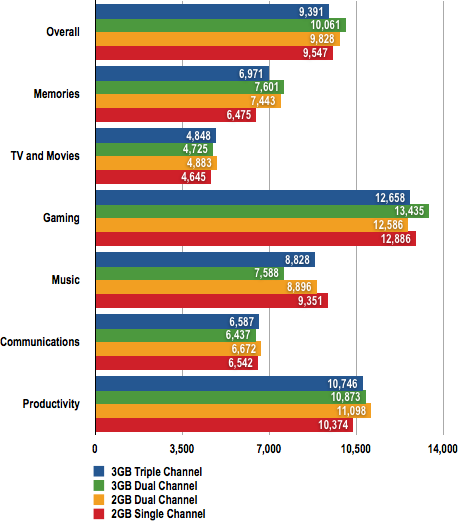
Longer bars are better
We used PCMark Vantage to see what effect these huge changes in memory bandwidth would have across a range of tasks and were only slightly surprised to see that the answer is ‘very little’. The system delivers stacks of performance with 2GB of memory in single-channel mode which barely changed when we switched to 2GB in dual-channel mode. 3GB of dual-channel memory is a surprisingly effective configuration, while triple-channel appears to be a small step backwards.
Verdict
Don’t worry too much about triple-channel memory as two channels work just as well.
Memory speed and overclocking Core i7
When you overclock a Core i7 965 or 975 Extreme, you have the option of raising the multiplier. However, anyone with a Core i7 920 is obliged to raise the 133MHz base clock speed as the clock multiplier can't be raised above the standard 20x speed.
PCMark Vantage Results
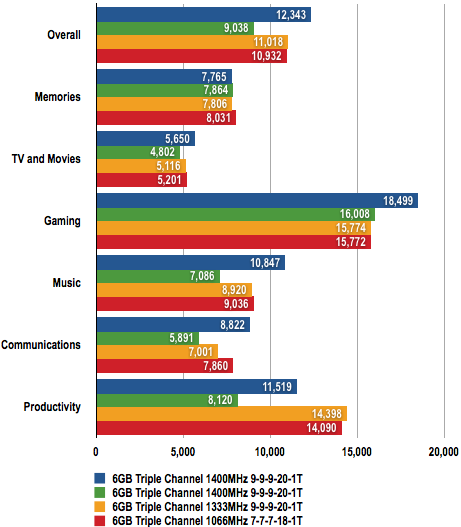
Longer bars are better
For this set of test runs we switched to an EVGA X58 SLI motherboard as the overclocking options are relatively limited on the Intel DX58SO. As we were going to overclock the memory, we switched from the Qimonda 1066MHz DDR 3 to OCZ Reaper 1800MHz DDR 3. This happens to be a 3x2GB kit, so we installed 64-bit Vista on the Intel X25-M SSD.
We ran the Core i7 at three different base speeds and dropped the clock multiplier to keep the processor clock speed constant. For the first run, we tested the Core i7 920 at the standard speed 2.66GHz (20 x 133MHz) with the memory running at 1066MHz. Next we raised the base speed from 133MHz to 166MHz and dropped the multiplier to give a speed of 2.66GHz (16 x 166MHz) which raised the memory speed to 1333MHz. The increase in memory clock speed slowed the SPD settings from 7-7-7-18-1T to 9-9-9-20-1T. However, the memory bandwidth was increased and the latency reduced. This is all good positive stuff but the effect on system performance was negligible.
For the next step, we raised the base clock to 175MHz and reduced the multiplier to 15x for a processor speed of 2.63GHz and a memory speed of 1400MHz. There are ‘natural’ speeds for memory that are set in the SPD.
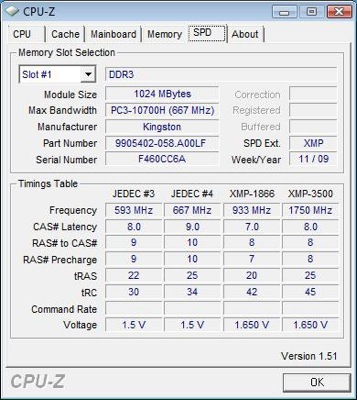
For most DDR 3 chips, these speeds will include 1066MHz, 1333MHz, 1600MHz and 1866MHz, while odd speeds, such as 1400MHz, tend to throw things out of kilter. On these settings, the memory bandwidth increased slightly. However, the system performance dropped quite markedly. The object of this particular exercise was to overclock the Core i7 920 so we reset the clock multiplier to the standard 20x figure while keeping the base clock at 175MHz and the memory still at 1400MHz which raised the processor speed to 3.50GHz. That’s a healthy overclock from 2.66GHz and the extra performance is impressive but running the memory at an unnatural speed hurts performance.
SiSoft Sandra Results
Bandwidth
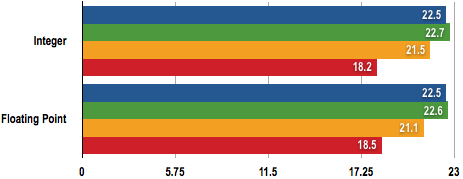
Memory Bandwidth in Gigabytes per Second (GB/s)
Longer bars are better
Latency
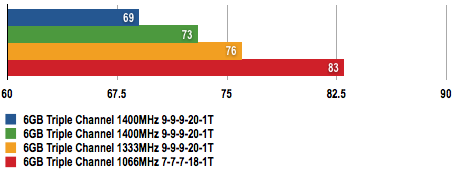
Memory Latency in Nanoseconds (ns)
Shorter bars are better
Verdict
Overclocking your Core i7 is a very good idea, but the memory speed is merely a tool that helps to unlock the performance in the processor.
What speed memory should you use to get the best from Core i7?
We had a torrid time trying to raise the memory speed to 1600MHz on the EVGA X58 SLI. This is something of a puzzle as the EVGA manual explicitly states that the board supports memory speeds way beyond 2000MHz. Furthermore, the EVGA forums give a detailed guide to overclocking.
We spent ages trying all manner of settings and different types of memory, but we got nowhere fast. It was time to switch motherboard yet again. This time we tried an Asus P6T SE and suddenly we found that the memory would run at really high speed.
SiSoft Sandra Results
Bandwidth
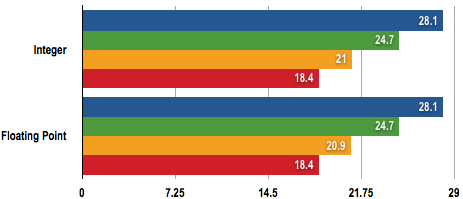
Memory Bandwidth in Gigabytes per Second (GB/s)
Longer bars are better
Latency
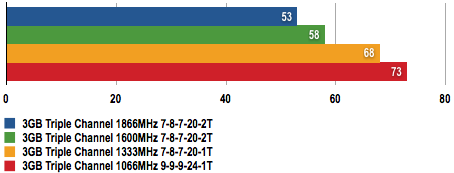
Memory Latency in Nanoseconds (ns)
Shorter bars are better
We installed a Core i7 965 Extreme processor on the Asus along with 3x1GB Kingston HyperX DDR3-2000 running 32-bit Vista and tested the memory running at 1066MHz, 1333MHz, 1600MHz and 1866MHz. SiSoft Sandra showed that the memory bandwidth increased by 10GB/s from 18GB/s to 28GB/s.
This enormous change was barely reflected in PCMark Vantage as the Overall score barely changed one iota. The most obvious benefit of the increased memory speed was in the Productivity section of the benchmark but generally speaking the results were unimpressive.
We were unconvinced by these results and installed 6x2GB of OCZ Reaper DDR3-1800 on the Asus running on 64-bit Vista. Increasing the amount of memory from 3GB to 12GB yielded improvements in Vantage's Overall results. However, the 12GB system didn’t show any benefit when we increased speed from 1066MHz to 1333MHz and onwards to 1600MHz. The figures show that the Gaming element of PCMark Vantage increased as the memory speed got higher, but the Productivity test results decreased. That’s right the results decreased where they increased on the 3GB 32-bit system. Historically, we've found that PCMark Vantage is a very good guide of system performance.
PCMark Vantage Results
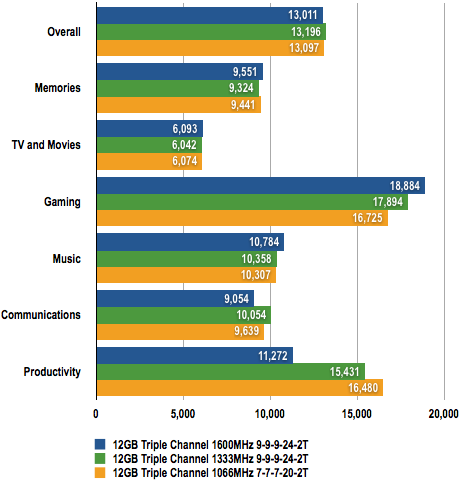
Longer bars are better
Verdict
Don’t get stressed about running a high memory speed on Core i7. You’re probably better off using 1333MHz than 1066MHz, but we are sure that 1600MHz and higher speeds are a fruitless exercise.
What quantity of memory should you install in your Core i7 system?
Once we had settled on the Asus P6T SE motherboard with OCZ Reaper memory we carried out a final simple test. We benchmarked the system with 12GB of triple-channel memory and then reduced the amount of memory for subsequent tests.
PCMark Vantage Results
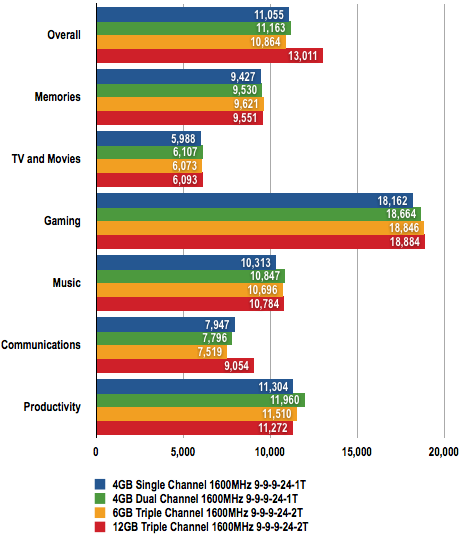
Longer bars are better
SiSoft Sandra Results
Bandwidth
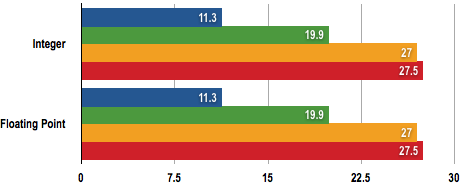
Memory Bandwidth in Gigabytes per Second (GB/s)
Longer bars are better
Latency
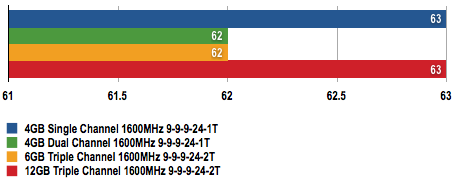
Memory Latency in Nanoseconds (ns)
Shorter bars are better
The next step was 6GB in triple-channel mode, followed by 4GB of dual-channel memory and, finally, we tested with 4GB of single-channel memory. The winning set-up was 12GB of memory in triple-channel mode but it occurred to us that suspicion may be hanging over PCMark Vantage. We ran a final benchmark with Far Cry 2 and found that the 12GB and 6GB triple-channel systems had a modest advantage over the 4GB dual- and single-channel systems.
Far Cry 2 Results
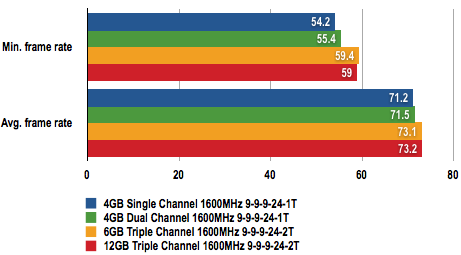
Frames per Second (f/s)
Longer bars are better
Verdict
Stuff your 64-bit Core i7 system with 12GB of memory and you’ll reap the benefits.
Final Verdict
So there we have it: the Core i7's triple-channel memory controller shows little benefit over dual-channel but it doesn’t do any actual harm. Running astronomical memory speeds on Core i7 is a bit of a lost cause, and we recommend you stick to a maximum speed of 1333MHz, although the default 1066MHz speed works very nicely too. 12GB of memory works well but you’ll need a 64-bit operating system, and that's the real conclusion that we are taking away from all these days of testing. Don’t build a new Core i7 PC and run 32-bit software, but instead make the jump to 64-bit and pack it full of Ram. ®
